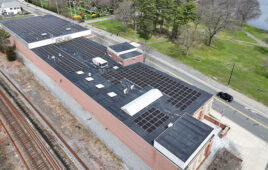
The 1-MW photovoltaic array at the Flatirons Campus (FC) of the National Renewable Energy Laboratory (NREL) has a backdrop of the foothills of the Rocky Mountains. (Photo by Werner Slocum / NREL)
Incorporating energy efficiency measures can reduce the amount of storage needed to power the nation’s buildings entirely with renewable energy, according to analysis conducted by researchers at the U.S. Department of Energy’s (DOE’s) National Renewable Energy Laboratory (NREL).
As more communities plan to eventually rely on 100% renewable energy, the researchers offer a strategy that could guide their paths — one that shifts away from long-duration storage.
“Minimizing long-duration storage is a key element in trying to achieve the target cost-effectively,” said Sammy Houssainy, co-author with William Livingood of a new paper that outlines an approach to 100% renewables. The research paper, “Optimal Strategies for a Cost-Effective and Reliable 100% Renewable Electrical Grid,” appears in the Journal of Renewable and Sustainable Energy.
The researchers considered solar and wind as the source of renewable energy, given that most plans for meeting the 100% target take those into account. They also used the Department of Energy’s EnergyPlus and OpenStudio building energy modeling tools to simulate energy demand, considering such factors as building size, age and occupancy type. Data from the U.S. Energy Information Administration informed the scientists about the existing building stock characteristics and energy load used by the buildings.
Further, the researchers separated the country into five climate zones, ranging from the hot and humid (Tampa, Florida) to the very cold (International Falls, Minnesota). The other zones encompassed the cities of New York, El Paso and Denver. Knowing the extremes of heating and cooling demands in each zone enabled the researchers to select the appropriate mix of renewable power sources to minimize any needed storage.
While varying definitions exist in the literature, for purposes of this study the researchers define long-duration storage as energy storage systems that meet electricity demands for more than 48-hour durations. Therefore, long-duration energy storage provides power days or months after the electricity is generated. However, most long-duration storage technologies are either immature or not available everywhere. The two NREL researchers calculated reaching the last 75% to 100% of renewable energy would result in significant increases in costs associated with long-duration energy storage. Instead of focusing on storage, the researchers emphasized the optimal mix of renewable resources, oversized generation capacities and investments in energy efficiency. The researchers note that multiple pathways exist to reach 100% renewable and, as the costs and performance of technologies change, new pathways will emerge, but they identified a key pathway that is achievable today.
They also determined that oversizing renewable capacities by a factor of 1.4 to 3.2 and aiming for 52% to 68% in energy savings through building energy-efficiency measures lead to cost-optimal paths depending on region of the country. Houssainy said making homes and offices more energy efficient reduces the amounts of renewable resources needed, decreases the amount of storage, and cuts transmission costs, ultimately supporting the implementation of a carbon-free energy system.
“What’s included in the paper is really a multistep process to follow,” Livingood said. “That process is applicable to large cities, as well small cities. Now, the end result will change, city to city, as this multistep process is followed to cost-optimally achieve the target.”
For example, Tampa would generate all of its electricity from solar panels, while International Falls would receive 100% from wind turbines, the researchers calculated, in order to have the least reliance on storage.
“It is not intended to replace the need for site-specific, detailed engineering design and planning processes for buildings, electric grid and energy infrastructure,” Livingood said, “but we believe that our novel calculation methodology yields overarching concepts and conclusions that are broadly relevant and applicable. For cost-effectively achieving 100% renewable scenarios, our newly developed calculation methodology provides general principles that help guide these detailed engineering design and planning processes.”
DOE’s Building Technologies Office funded the research, under the advisement of Andrew Burr (formerly DOE).
News item from NREL





You are on the correct track. Tell the Commonwealth of Massachusetts because they are relying on renewable generation from wind, hydro Quebec, and solar PV. Little energy conservation so that the local utilities can transport the most electricity and make the biggest profit.
I appreciate learning about these sensible approaches to 100% clean energy. Banking on long-term storage would increase costs and thus increase resistance to achieving 100% clean energy and we need clean energy to avoid the worst effects of climate change.
Although not mentioned here, my earlier study of hydrogen as a long-term energy storage medium overlooks the inefficiency of using producing hydrogen using electrolysis and later using fuel cells to recover the electricity. There are other potential long-term storage options to cover the last few percent of energy demand.
Solar energy for home owners works best if it’s decentralized, right? We need incentives for homeowners to put solar panels on their homes and garages – particularly valuable in rural areas – with the option to sell power back to the grid.
Let me know which companies are working on this – decentralized solar is what makes the most sense for consumers.